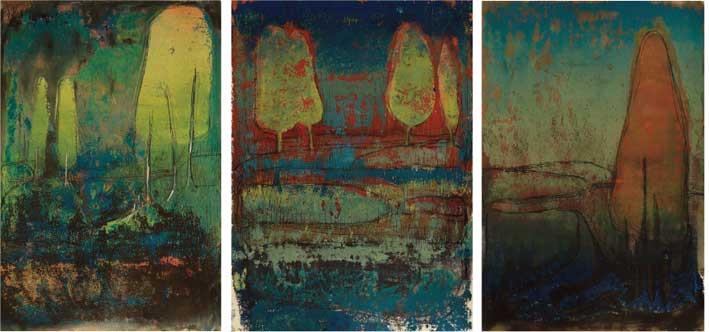When Ernest Callenbach wrote his now legendary novel Ecotopia in 1975, he unwittingly fathered an international movement directly inspired by the ecological possibilities outlined in his book. He wrote about a world intent on reducing its carbon footprint, prepared to recycle and reuse, re-become self-sufficient and learn how to obtain its energy from natural sources. A world reality which many of us are trying to embrace.
Roderick Camilleri's exhibition entitled Ecotopias is his first solo of the year and has seen him launch into new experimentation both artistically and philosophically. The modest collection of exciting works being shown within the intimate space of Il-Kamra ta' Fuq, provides insight into his frame of mind throughout the preparatory phase of the show. The theme is nature as never seen before, nature created in the mind of an artist visualising an idyllic landscape inspired by the very concept of an ecotopia.

"My exhibition seeks to transmit the mindset I had when working on this selection. The idea was born as an off-shoot from my previous solo exhibition of 2021 where I concentrated on the theme of dystopia. Here I am now moving beyond man himself, beyond the trudgery that can be life and beyond man's struggles to overcome all adversity. I am now taking an imaginative approach towards the other-worldliness of socio-ecological justice, where nature reigns un-encumbered and free." Indeed, in Ecotopias the body of works is not only visually different from his previous show, but also hints at a lighter mood and hope for the future, as the survival of organisms manifests in a world where man has not set foot. A nirvana for Mother Nature.
Connoisseurs, who follow Camilleri's oeuvre to date, will easily recognise the different stance adopted by the artist. The colours are softly vibrant, the technique further refined and engineered, so that what begins as creative experimentation, leads to a working relationship allowing the artist to improvise while manoeuvring his medium towards an effective finish. It takes skill and concentration to allow these techniques to manifest freely yet remaining in control. Each work takes several hours to complete, as every individual layer is painstakingly composed, allowed to rest, and the time in-between taken up to study a way forward. "The materials I use and the techniques themselves provide a constant challenge. The first process is a cross between printing and etching. I have used gouache and occasionally ink or chalk in the interim connecting the two processes. I wait and see through the work as it spontaneously helps me to improvise upon my basic idea, and even while the materials do dictate through their own behaviour and interaction with each other, with careful manipulation I work to coax them towards a finale that expresses my initial thought nonetheless."

Camilleri's imaginative approach, tinged with scientific experimentation, speaks of the dignity of an ecology that distances itself from man's intervention and is de-colonized from human touch. He gives a distinct character to each frame, tantalisingly capturing light, dappled, soft or diffused, yet mellow and always pleasing. There is no hint of heaviness and each of these works expresses a scenario that is surreal, yet pleasingly possible. The blues are not where one would expect them to be; the warmth and reflection of a sun-down or sunrise is properly harnessed, at times surprisingly intent on teasing the viewer's perception of the composition. The forms belong to trees and organic beings, but one would struggle to identify any species with a definition. But the viewer can identify their presence as living throbbing beings with a life of their own. Four etchings in dry point and hard ground accompany the collection, and still the language remains unique throughout - the artist captures the ambience of a raw natural environment, indicating an autonomy that we all forgot nature possessed.
Camilleri's own efforts to reduce his carbon footprint as an artist go one step further as he explains, "I often seek out different types of paper to work on, paper made from natural products such as algae, olive leaves or almond shells. It is interesting to understand how these are produced, how they can be used and to be able to utilise them wisely and carefully. Their presence in some of my work gives it another dimension, and it is my own way of appreciating how even as an artist, I can remain in touch with nature and the never-ending richness that it proffers to us."
The Ecotopias exhibition is curated by Art Sweven and is showing at Il-Kamra ta' Fuq, 4 New Life Bar, Church Square, Mqabba until 11 July. Opening hours: Monday to Saturday: 6am till noon; Sundays: 7am till noon; Evenings 7-9pm announced weekly on Facebook: il-Kamra ta' fuq.